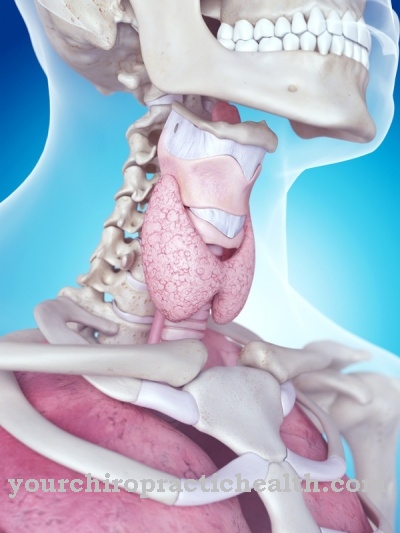Of the FISH test is a microscopic chromosome test in prenatal and carcinoma diagnosis of breast cancer, gastric cancer and chronic lymphocytic leukemia. The test, the result of which is available within 1 to 2 days, can primarily identify chromosomal abnormalities that can be traced back to an altered set of chromosomes in certain chromosomes. The test is only carried out as an accompanying or preliminary test for a detailed chromosome analysis, the results of which are only available 2 to 3 weeks after the cells have been removed.
What is the FISH test?

The FISH test (Fluorescence in situ hybridization) in prenatal diagnosis allows conclusions to be drawn about a changed set of chromosomes for certain chromosomes. To carry out the FISH test, at least 50 uncultivated fetus cells (amnion cells), which are taken from the amniotic fluid (approx. 2 - 3 ml), are required. An alternative method for obtaining suitable cells is the chorionic villus sampling, in which cells are taken from the area of the umbilical cord attachment by biopsy.
A special procedure allows the individual strands of chromosomes 13, 18, 21 and the X and Y chromosomes to be differentiated by fluorescent colors, so that a possible trisomy is noticeable through the presence of three instead of two homologous strands of a chromosome . In gastric and breast cancer, the FISH test can be used to check whether the tumor has more than two copies of the HER2 / neu gene (human epidermal growth factor receptor), which has consequences for the type of chemotherapy. In diseases of chronic lymphocytic leukemia, the most frequent chromosome shifts in certain genes can be determined by means of several FISH test analyzes in samples from bone marrow and peripheral blood, which also has an impact on therapy.
Function, effect & goals
The chromosomes in the isolated cell nuclei are made to split their double helix structure by a special chemical treatment or by the action of heat, and chromosome-specific DNA probes with the respective complementary DNA sequence connect to “their” specific chromosomes. The DNA probes are marked with different colored fluorescent colors so that the marked chromosomes can be distinguished from one another using special software and counted in an automated process.
Are known z. B. Trisomies in which there are three instead of two chromosome strands for one chromosome. So-called monosomies are also known in which only one strand of the X chromosome is present and three or four homologous strands of all chromosomes. The most important chromosome changes that can be detected with the FISH test in prenatal diagnosis are Ullrich Turner syndrome (monosomy X), triple X syndrome (trisomy or polysomy X), Klinefelter syndrome, in which in all or some of the somatic cells in boys have an additional X chromosome (XXY instead of XY), Down syndrome (trisomy 21), Edwards syndrome (trisomy 18) and Patau syndrome (trisomy 13).
Monosomy X, in which girls only have one X chromosome, is usually fatal, which means that in about 98% of cases it leads to a miscarriage within the first three months of pregnancy. In the event that a birth does occur anyway, the girls have a normal life expectancy, are of average intelligence, but often suffer from a number of malformations of internal organs and are mostly sterile. The triple X syndrome with the chromosome set XXX) only affects girls. Normal pregnancy and childbirth is possible.
The mostly tall women with the triple X chromosome can live normally and usually show no physical abnormalities, although learning difficulties are not uncommon and problems with fine motor skills occur. Klinefelter syndrome, which can only affect boys and men, is characterized by an additional X chromosome that is present in all cells of the body or only partially.Physical characteristics are above average height with unusually long arms and legs. Klinefelter syndrome usually leads to reduced testicular growth with reduced testosterone release.
Down syndrome, synonymous with trisomy 21, is mostly associated with certain physical characteristics and with cognitive impairments. There are different forms of trisomy 21, of which the so-called free trisomy 21 is predominant in about 95% of cases. Trisomy 18 (Edwards syndrome) causes miscarriage in most cases, is associated with a variety of physical features, and life expectancy is only a few days. Trisomy 13 (Pätau syndrome) is also characterized by a large number of physical features and undesirable developments, which often lead to miscarriages or stillbirths. Life expectancy for children at term is only a few years.
The aim of the prenatal FISH test is to detect known chromosomal abnormalities at an early stage in order to offer the parents the alternative of a legal abortion to carry the child to term. In breast and liver cancers, the carcinomas can be checked for an increased number of the HER2 / neu gene using the FISH test. In the positive case, there is an increased formation of growth factor receptors that respond to certain chemotherapies. FISH tests are also available to detect specific genetic abnormalities in chronic lymphocytic leukemia (CLL) that improve the composition of effective chemotherapy agents.
Risks, side effects & dangers
The FISH test itself is not associated with any risks or dangers. Only the extraction of the cells to be examined by biopsy or by sampling the amniotic fluid (amniocentesis) are associated with a minor risk of infection due to their invasive character. The specialty is that the FISH test can reveal some specific chromosomal defects, but it cannot be guaranteed that there are no chromosomal aberrations in the case of a negative result, as not all anomalies can be detected by the FISH test. In the event of a positive test result, further diagnostic procedures should follow in order to confirm the result or to reject it as false.













.jpg)

.jpg)
.jpg)











.jpg)